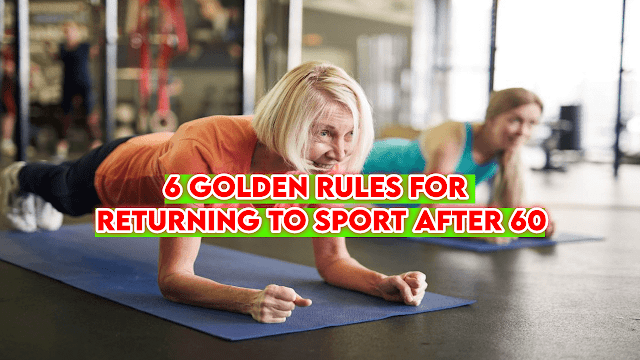6 golden rules for returning to sport after 60
After 60, you have to move, but not just anyhow. Our advice for (re)confidence.
"Even if we start at 60, it's never too late!" Encourages Dr. Hélène Gaumerais, doctor at the thermal baths of Saint-Malo. Regular physical activity (at least thirty minutes a day, five times a week) would reduce the risk of developing diabetes mellitus and cardiovascular disease. It would even delay the onset of Alzheimer's... So, yes, we move, but not just anyhow.
"The objective is not to sweat at all costs, to suffer, nor to achieve performances unsuited to one's physical condition, underlines coach Jean-Pierre Clémenceau, but to age 'well' by maintaining one's bone, muscle and heart. With age, we tend to stiffen up, become short of breath and gain weight (after menopause). We therefore seek above all to regain ease and mobility in our movements, flexibility, breath and a toned silhouette."
Treat yourself to a real health check
It's about knowing your real physical condition. It is not just about taking your blood pressure and stamping on a certificate: the doctor, general practitioner or sports doctor, must ask you about your history (cholesterol, hypertension, shortness of breath, etc.) and your lifestyle (tobacco , physical inactivity, stress, etc.). It is necessary to do at least a biological blood test and an electrocardiogram at rest. Depending on your history, the doctor will request an opinion from the cardiologist and a stress test, to assess the adaptation of the heart to physical exercise and detect any pathologies. Through a clinical examination, he will assess your body mass index, your flexibility and your joint mobility.
Forfeit Champion Objectives
Forget the challenges with promises that are too enticing to be true (“thirty days for abs on top”). No question either of running like mad or embarking on ultra-dynamic yoga twists if you suffer from osteoarthritis. "What matters is to go gradually. If you start brisk walking, you limit yourself to at least five weekly sessions of thirty minutes. Gradually, you improve your breath, you can walk faster and longer, until you reach 5.5 to 6 km/h", advises Dr Gaumerais. "On the fitness side, two weekly sessions of forty-five to sixty minutes are enough, adds Jean-Pierre Clémenceau. Beyond three, you risk forcing yourself, injuring yourself... and giving up. To start the gym, the Pilates, abs-glutes or Hatha yoga, we aim for the beginner or intermediate class if you are flexible and comfortable, but we avoid the intensive level.
Get coached by a pro
Technical advice, encouragement, evolving program... being accompanied by an experienced athlete avoids injuries, demotivation and abandonment. Coaching (often included in room registrations) allows you to become familiar with the treadmill, the elliptical trainer, the rower... and to learn to coordinate your movements. Alone or with others (it's cheaper), at home or in a park, you can book two or three sessions with a coach. We train to alternate running and brisk walking for a few minutes, and we learn the right positions and exercises to target the muscles that we want to strengthen first. For example, use weights of 500 g to 1 kg to revitalize the triceps of the arms, which relax more quickly in women.
Build muscle to build old bones!
From the age of 50, we lose muscle mass and bone density. "Before this age, men and women have a decrease of 0.5% to 1% per year in their bone mass. But in women, after menopause, this loss will increase by 3% per year for five years," explains Dr. Gaumerais. However, a good musculature of the abdominal belt, thighs (psoas) and buttocks improves physical condition and prevents back pain." The important thing? "Choose a sport that you love!", insists the doctor. Wearable activities such as Aquagym, aquatraining (jogging in water with a flotation belt) or aquabike are recommended, as they are less traumatic for the joints. "The heart being the body's "engine", walking fast is also a simple way to maintain and revitalize the heart muscle, adds Jean-Pierre Clémenceau. And burn localized fat on the abdomen!
To find the right person !
"Beware of inflammation caused by ill-fitting sneakers, alert Jean-Pierre Clémenceau. Cushioning, pads, soles... Seek advice from a podiatrist or a specialist salesperson who will examine your flat foot and determine your gait (universal, pronator or supinator)." And we don't skip any steps, because good equipment does not replace warming up (ten to fifteen minutes)! We do not rush it, under penalty of traumatizing its joints.
be regular
In order to permanently install his sports sessions in his agenda, we take care of everything! To self-motivate, we plan them in the same way as our other appointments. And we find a room close to home – if we have to cross the city, we will always have an excuse not to go there.
To fight against the anonymity of the big clubs, we train a girlfriend. The "locked" side weighs on you? Going along the coast (by the sea) or Nordic walking in the forest allows you to move around in the open air, often in a friendly atmosphere. Reassuring and motivating!













Post A Comment:
0 comments: